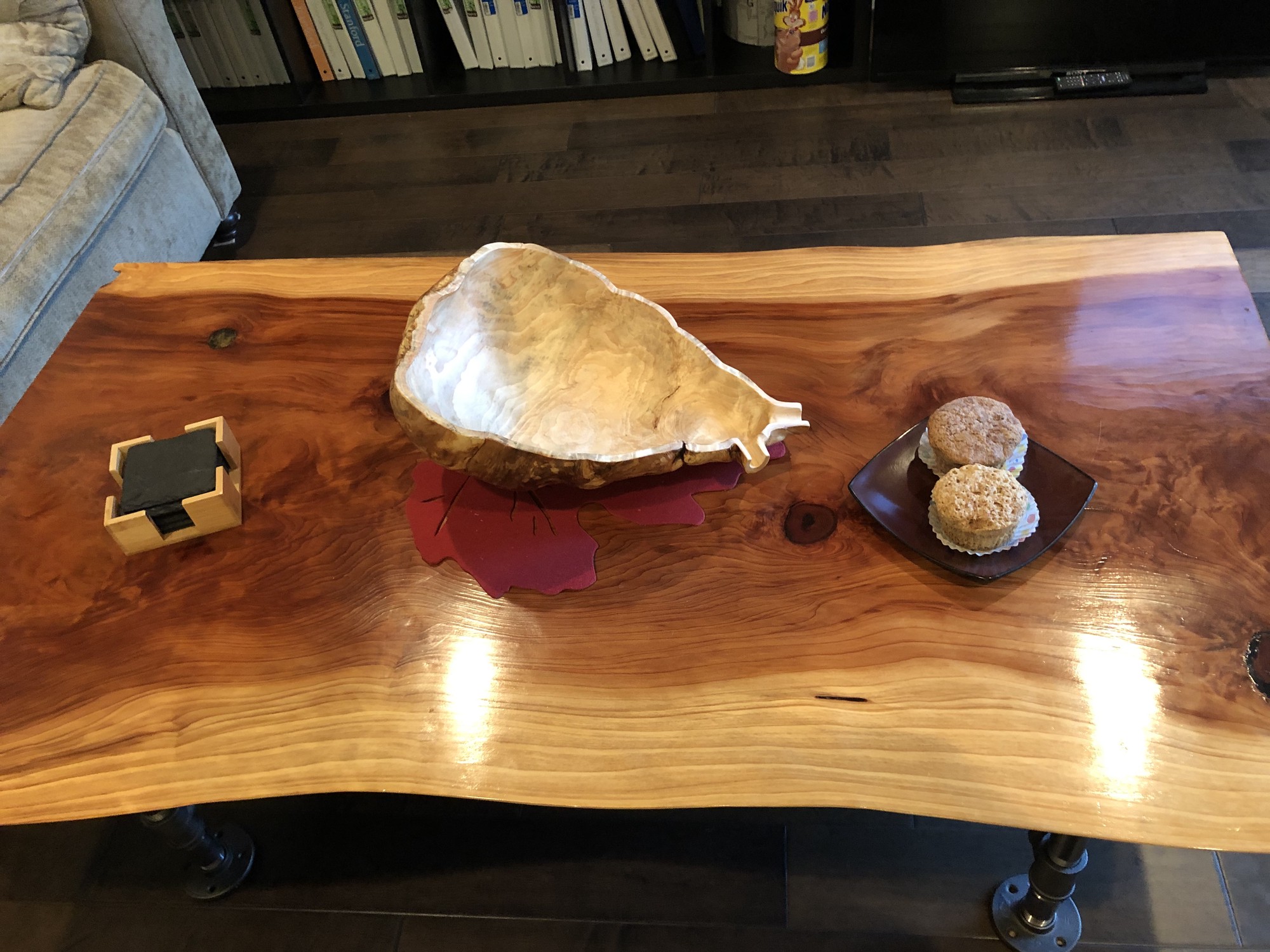Wood Bowl

This is my ninth and largest wood bowl to date!
Table of Contents
Overview
- Start: Mar 27, 2021
- End: Apr 13, 2021
- Wood Species: Jack Pine
The burl for this bowl was collected at the same general location as the burl for a separate bowl project in Minnesota. It was extracted and completed in a similar manner to that burl/bowl.
Burl Splitting
This burl was quite large and I decided to cut the burl in half and make two bowls out of it. Stay tuned for the bowl resulting from the other half.


Bark Removal
My next step was to remove the bark from the burl. Because I allowed the burl to dry with the bark attached, removing the bark was difficult. I first used a hammer and wood chisel until I had removed the hardest bark. I then used a drill and red nylon drill brush1 to remove the remaining bark. The brush was soft enough to not damage the underlying wood.


Carving
Next, I needed to find a way to safely and accurately hollow the bowl.
Precise control here was critical because penetrating through the bowl edge was a non-starter.
I used the Orbicut 40 bit2 to hollow the bowl.


Inner Finish Work
Sanding
Next, I moved on to sanding/polishing the inner surface of the burl, partially to even out the divots formed from the Orbicut 40’s spherical shape.
I started with refining the hollowing divots with an 80 grit flap wheel3.

Fine Reshaping
There were some nobs where branches had protruded from the burl. I wanted to hollow these out to give a trimmed appearance to the bowl.
To initially hollow the nobs, I used a fine, rotary burr by Kutzall4.

I then further refined the hollowed nobs using a dremel 240 grit drum sander5, a small 220 grit flap wheel and 320 grit sandpaper.

Polishing
Lastly, I used orange nylon wheel6 and 320 grit sandpaper (only on the inner surface and bowl edges) to effectively finely sand/polish the inner and outer surfaces and to give the edges of the bowl a rounded, gentle feel to the touch. This wheel didn’t appear to leave residue and was able to polish and sand minor carving scratches. Furthermore, it was highly effective at cleaning and polishing any cracks and uneven features in hard-to-reach areas.

Wipe Down
Before applying the finish coats of oil, I wiped-off as much of the residual sawdust from the burl as possible using a lightly dampened, paper towel.


Finish Coats
The last step was to apply finish to stain and protect the bowl as well as to enhance the chatoyancy of the bowl. For this I used Walnut colored Rubio Monocoat7 following the instructions on the back of the can. This finish is highly respected in the woodworking community as it is in-grain, requires just one application that takes about 15 minutes to apply and once dried (after ~5 days), is food-safe.

Finished Bowl





Cheers!
-
https://www.amazon.com/Nylon-Abrasive-Wheel-Brush-Shank/dp/B07QDRCBBT ↩︎
-
https://www.amazon.com/OrbiCut-Speed-Cutting-Tool-Plano/dp/B01N5YGI35 ↩︎
-
https://www.amazon.com/DEWALT-DAFE1H0810-3-Inch-1-Inch-4-Inch/dp/B003N9BT4Q/ref=sr_1_3?dchild=1&keywords=80+grit+dewalt+flap+wheel+sanding+drum&qid=1618952626&sr=8-3 ↩︎
-
https://www.amazon.com/gp/product/B0037MOAQS/ref=ppx_yo_dt_b_asin_title_o06_s00?ie=UTF8&psc=1 ↩︎
-
https://www.amazon.com/Dremel-445-grit-sanding-band/dp/B000WMIROM/ref=sr_1_4?dchild=1&keywords=dremel+drum+sander+220&qid=1619025626&s=hi&sr=1-4 ↩︎
-
https://www.amazon.com/Dico-7200048-Medium-Nyalox-Wheel/dp/B002YDJU98/ref=psdc_2665581011_t1_B011ICDVJA?th=1 ↩︎